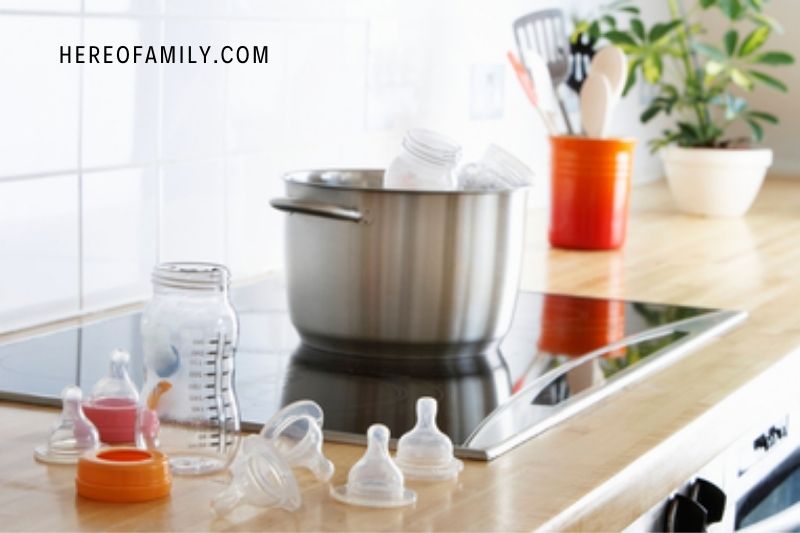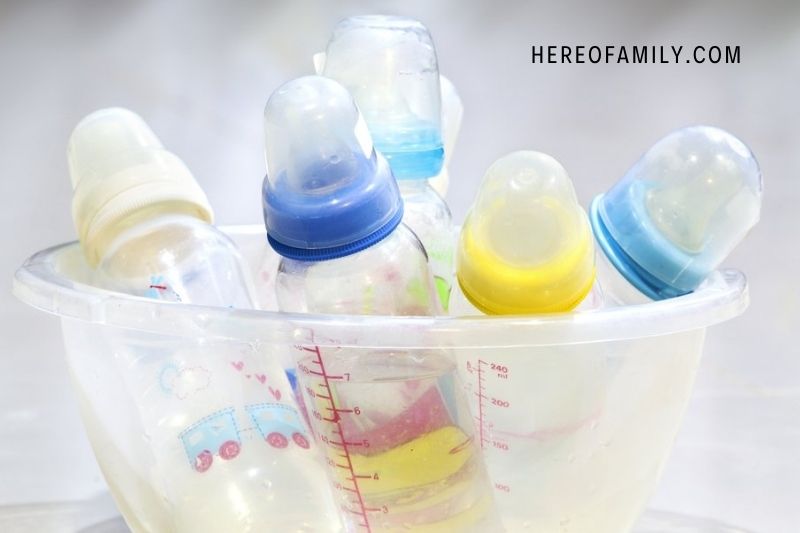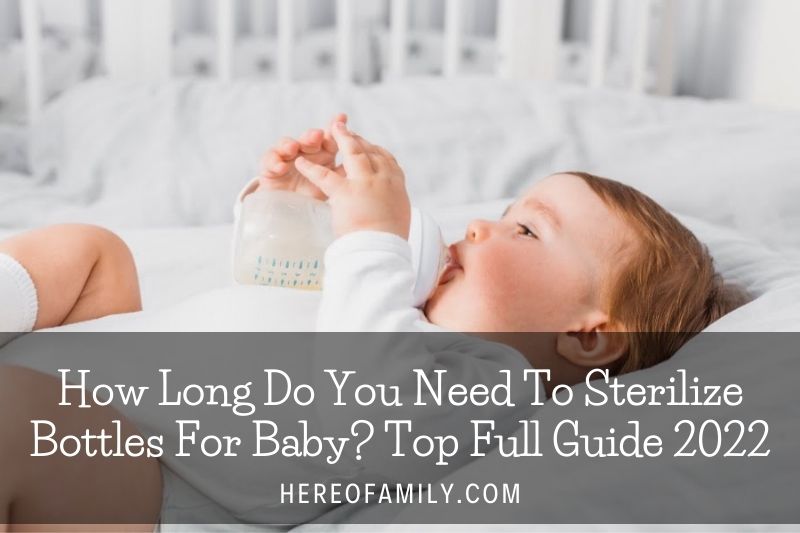When you are getting ready to have a baby, you need to know, “how long do you need to sterilize bottles?“. This ensures that the baby will not get any germs or bacteria that could make them sick. There are a few different ways to sterilize the bottles, and the method you choose will depend on how much time you have and what you have available.
Contents
How Long Do You Need To Sterilize Bottles?

Sterilizing infant bottles goes above and beyond standard cleaning to give further germ prevention. And, in general, it’s a one-and-done transaction. “It’s crucial to sterilize baby bottles at least once when you initially acquire them,” says Samira Armin, MD, Texas Children’s Pediatrics physician.
After all, you have no idea where that bottle was before it was packed and sold to you, so initial sterilization is a fast and simple approach to safeguarding a baby’s health and safety. “After that, sterilizing baby bottles or their attachments is no longer essential,” she continues. “Many years ago, when boiling water sources were not always clean, infant feeding items needed sterilization, but luckily, this is no longer a concern.”
There are times when you may wish to sanitize your baby’s bottle parts after the first usage. These, according to Hoff, are:
Suppose you are utilizing borrowed or used bottles. Some mothers buy all newborns’ equipment and materials at secondhand stores or borrow baby bottles from a friend. It is vital in these circumstances to sanitize previously used baby bottles before giving them to your kid for the first time. The same is true for baby bottles previously used for elder siblings in your family.
Suppose the infant has been ill. When your kid is ill, the last thing you want to do is risk reinfecting them by using dirty bottles. “If you’re worried about any remaining germs or harmful bacteria on your child’s bottles, sterilizing baby bottles will set your mind at rest,” Hoff adds.
Suppose the infant was born prematurely or has a medical condition. Sterilization is especially crucial if the infant was delivered preterm or has a weakened immune system, according to the Centers for Disease Control and Prevention (CDC).
Suppose you lack access to safe drinking water. If your residence is not in a municipality with good drinking water, you use well soapy water, or you’re traveling in a nation with dubious water, they sterilize baby’s bottles often. Once-daily or even after each use would be advisable to minimize the formation of hazardous germs.
Sterilizing your baby’s bottles is especially important if: You’re using secondhand or hand-me-down bottles for the first time. Your baby was born prematurely or has health problems. Your baby has been ill. Your home does not have safe, clean drinking water.
How Often to Sterilize Baby Bottles

As long as you have excellent quality municipal drinking water that isn’t from a well, sterilizing baby’s bottles isn’t essential (or even advised). “Regular sterilizing bottles might harm the bottle parts and cause toxins to leech into the breast milk,” says Daniel Ganjian, MD, a pediatrician at St. John’s Health Center in Santa Monica, California.
Because of worries about the chemical’s influence on child development, the Food and Drug Administration (FDA) prohibited the use of bisphenol A, or BPA, in baby bottles in 2012—but if you’re using older plastic bottles, check sure they don’t have the recycling number 7 stamped on the bottom.
It is entirely up to you how often you sanitize infant bottles, so do what feels appropriate for your family. Sanitizing baby bottles by hand is unnecessary if you use a dishwasher with hot water and a heated drying cycle to clean your child’s feeding utensils. Otherwise, the CDC recommends sanitizing bottles at least once a day for further germ elimination beyond routine cleaning.
When To Stop Sterilizing Baby Bottles
If you decide to sterilize the sterilize baby’s bottles regularly, the CDC recommends stopping after the baby is older than three months since the infant’s weakened immune system is no longer vulnerable.
If you observe any damage, you should also cease sterilizing infant bottles and equipment, according to Ganjian. Glass bottles with cracks or chips and plastic bottles with splits, cracks, strong smells, or warping should be discarded. Bottle nipples that show signs of wear and tear should always be changed since they might pose a choking danger.
How To Sterilize Baby’s Bottle?
The CDC suggests sanitizing a baby’s bottle using hot water, a dishwasher, or steam (a microwave or specialty bottle sanitizer). If none of the other choices are available, the CDC recommends sterilizing using bleach as a last resort.
Need these procedures to sterilize the bottle brush, basin, and other bottle brush components that you use to wash the baby bottles.
Let’s go through each method for sterilizing a baby’s bottle brush step by step.
Sterilizing Baby’s Bottle With Boiling Water
- Before sanitizing, wash all portions of the bottles according to the CDC and follow the manufacturer’s instructions.
- Fill a big clean kettle halfway with water to thoroughly cover the bottles.
- Fill the bottles with water by placing them upside down (or on their sides) in the water. Make sure there are no air bubbles trapped in the bottles.
- Place the bottles and the other dismantled bottle pieces in the water.
- Bring the water to a boil, then immerse the baby bottles for 5 minutes to sterilize. The CDC recommends 5 minutes, but verify what the manufacturer suggests for your place bottles.)
- Turn off the heat and use tongs to remove the sterilized bottle pieces.
- Allow the bottle pieces to air dry on a clean, dry dishcloth. Rub or blot the bottle components dry with a dish towel to avoid transferring germs from the towel to the bottle parts.
Sterilizing Baby’s Bottle In The Dishwasher
When you use hot water and a heated drying cycle (or a sanitizing cycle) to wash bottles in the dishwasher, the bottles are sterilized as you wash bottles. Before using this procedure, ensure sure the bottles are dishwasher-safe.
- Separate all of the bottle components.
- Before putting the bottle parts in the dishwasher, rinse them under running water.
- Put the bottle components in the dishwasher. Put the little bits in a basket or mesh bag to prevent them from falling into the dishwasher filter.
- Use hot water and the heated dry option in the dishwasher.
- Before taking the bottle parts from the dishwasher, properly wash your hands. To mix powders or concentrates, use clean tap water.
- Allow the bottle parts to air dry fully on a clean cloth. Rub or blot the bottle components dry with a dish towel to avoid transferring germs from the towel to the bottle.
Sterilizing Baby’s Bottles With A Countertop Sterilizer
Countertop bottle sterilizers rapidly and conveniently eliminate germs from bottles and often reach greater temperatures than boiling water (for an even more thorough clean). To sanitize bottles, follow the manufacturer’s recommendations.
However, these electric sterilizers are the most costly alternative for sanitizing a baby’s bottle. As a result, you should generally only purchase one if you want to sanitize bottles regularly.
These countertop sterilizers utilize steam to clean bottles, but you may also sterilize baby bottles with steam in a microwave.
Sterilizing Baby’s Bottles With Steam In The Microwave
- Before sanitizing, wash all portions of the bottles according to CDC instructions.
- Check that the microwave is clean.
- Disassemble the bottles.
- In a microwave-safe dish, combine the nipples and rings. Set the dish aside for the time being.
- Half-fill the bottles with water.
- Microwave the water-filled bottles on high for one to two minutes.
- Allow the bottles to rest for a few minutes.
- Using oven gloves, remove the bottles from the microwave.
- Remove any residual water from the bottles and allow bottles air dry.
- Fill the microwave-safe dish halfway with water to cover the nipples and rings.
- Microwave safe bowl for 1–2 minutes.
- Allow the bowl to rest for a few minutes.
- Using oven mitts, remove the bowl from the microwave.
- Remove any residual water and let the bottle components air dry.
You may also buy a microwave sterilizer to speed up and simplify the steaming procedure. Microwave sterilizers are often half the price of a countertop sterilizer. They encapsulate the bottles to increase the effectiveness of the steam cleaning.
Sterilizing Baby’s Bottles With Bleach
If you cannot boil, steam, or use a dishwasher to sanitize baby’s bottles, the CDC recommends sterilizing with bleach as a last option.
- Combine 1-2 tablespoons unscented bleach and 16 cups of water in a clean washbasin.
- Disassemble the bottles.
- Completely immerse all of the bottles. Check that the solution covers all of the bottles and that there are no air bubbles in the bottoms of the bottles.
- Soak the bottles and components in water for 2 to 5 minutes.
- Tongs are used to remove the bottle pieces. Rinse, but do not re-rinse since this may return germs to the bottles.
- Allow the bottles to dry naturally on a clean cloth. (The bleach will degrade as the bottles dry and not harm the infant.) The CDC compares this to the bleaching partially used bottle to disinfect restaurant plates.)
A Note On Bottle Washing
Even if you don’t sterilize your bottles, you should clean them after each feeding since germs may grow in residual or leftover breastmilk/formula. According to CDC instructions, use the dishwasher (as stated above) to clean and sterilize the baby’s bottles or thoroughly wash them by hand with soap and hot water. If you wash the bottles by hand, wash the bottle brushes and do so in a separate sink.
Some relevant posts:
- Does Baby Powder Cause Cancer? Complete Guide 2023
- Best Baby Breathing Monitor: Keep Baby Safe and Sound 2023
- Is Wifi Safe For Babies? Top Full Guide 2023
- How To Help Choking Baby? Top Full Guide [2022]
- Check Neighborhood Safety 2023: Top Full Guide
- Is Daycare Safe For Infants 2023? Top Full Options Here!
- Where To Put Baby Monitor? Top Full Guide [2022]
Conclusion
If you’re wondering how long to sterilize baby bottles, the general rule of thumb is to do so for about 5 minutes. However, it’s always best to consult with your pediatrician to be sure. Thanks for reading!
